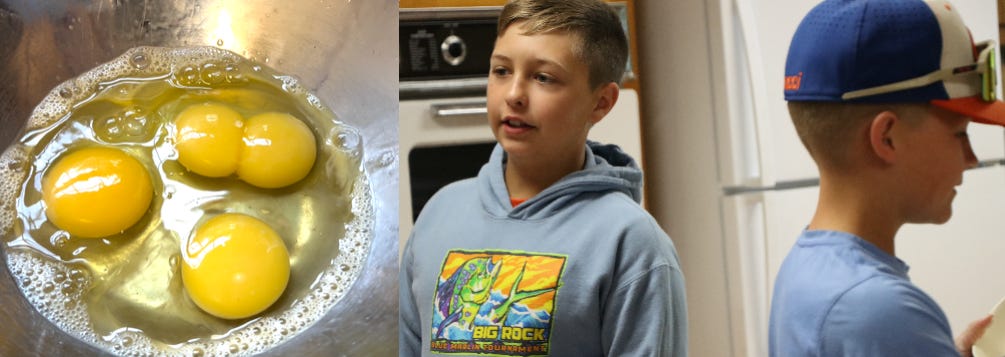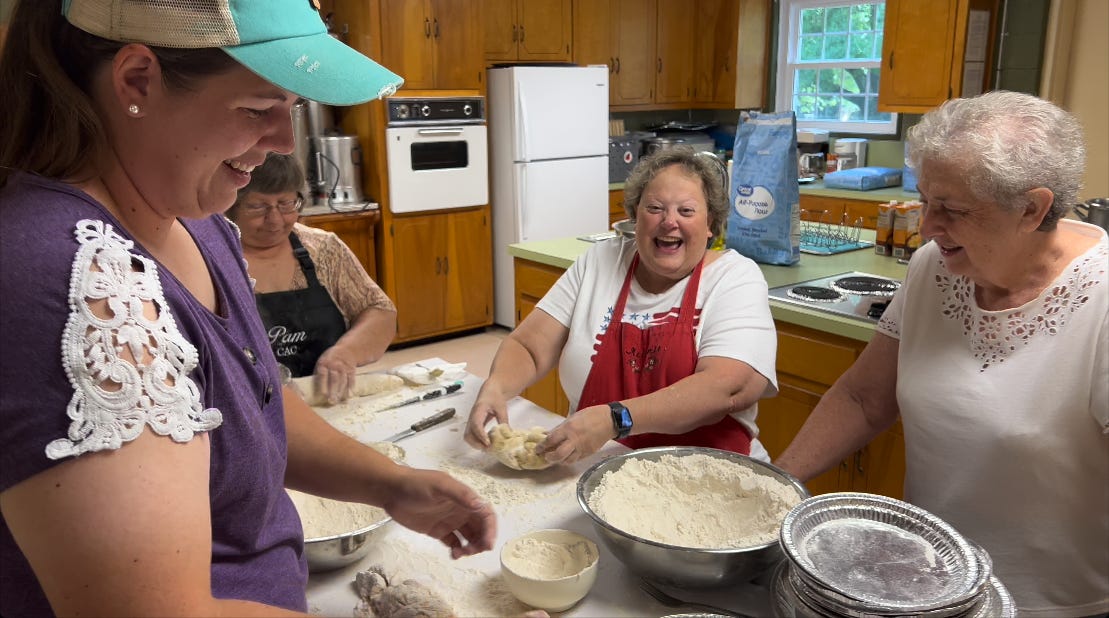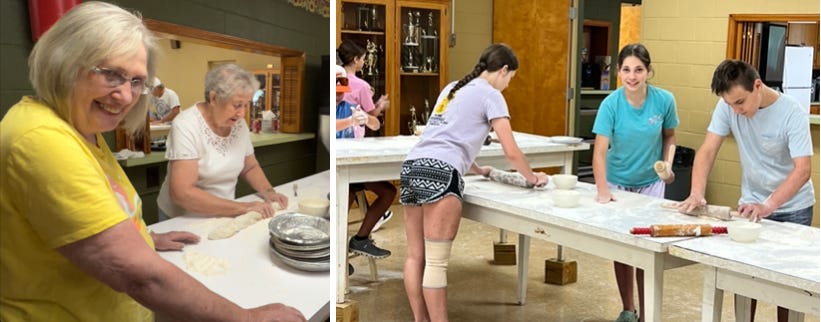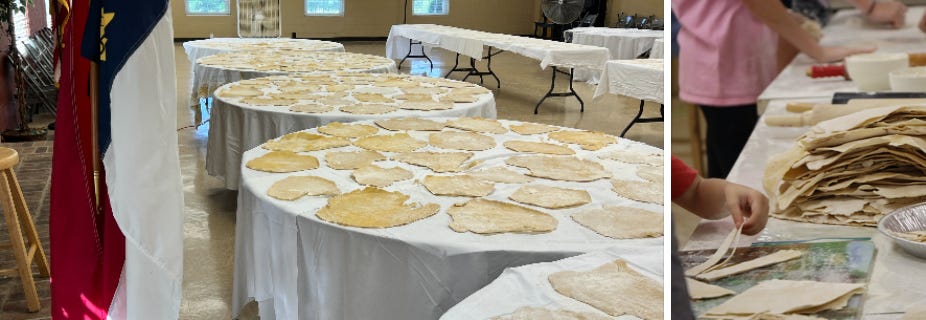North Carolina’s Mount Pleasant township and its 5,000 residents are spread across tracts of flourishing farmland, where small grains, hay, cattle, chickens, and, most recently, sheep and goats are being raised. To the west is sprawling Concord and the roaring Charlotte Motor Speedway. To the east, the ridges of the Uwharrie National Forest rise up with towering poplar, pine, oak, maple, sweet gum, and smaller redbud. This land, which explorer John Lawson called “delicious country,” was home to the Catawba people until European settlers traveling the Great Wagon Road moved in. Settled mostly by Lutherans from Germany before the Revolutionary War, Mount Pleasant is still a place where children aspire to till and tend the land that has been passed down through generations. That Charlotte is only minutes away seems impossible.
On an early morning in June, Donna Campbell and I find our way to Mt. Pleasant, seeking out St. John’s, the oldest Lutheran church in North Carolina, established in 1745. Today the congregation owns 100 acres, much of which is rented out for grazing cattle. There’s also a modest brick building set far back from the road and away from the church and its cemetery. In addition to serving as a fellowship hall, this building is headquarters for the Grange, the local manifestation of a nationwide community service organization focused on agricultural awareness and advocacy for farmers, founded in 1867. Behind the building, we find a dozen SUVs parked on the grass--no people in sight, though there are suspicious white footprints on the black asphalt leading to the back door.
We timidly knock and open the door into a big meeting room where flour dusts the floor. Workers, ranging in age from six to eighty-seven, barely look up from their tasks. I count fourteen rolling pins at stations in a long line of tables where men, women, and children are rolling dough into thin circles which are then lifted carefully and taken to rest on large circular tables covered in white sheets. About half the tables are already at capacity. The edges of the thin rounds of dough are beginning to dry and curl at the edges as fans blow over them from several directions. The air conditioning is cranked up to create a definite chill in the room.
In the adjacent kitchen, twin brothers, Tye and Avery, who are not yet twelve, are cracking eggs. Six eggs at a time go into each stainless steel bowl set before them. Avery explains that his brother Tye can tell which eggs have the twin yolks, even before he cracks them, but Tye has yet to explain how he knows this. There’s really not much time to mess around. The boys are assigned to whisk the whites and yolks into a yellow froth and deliver the bowls to their elders at the next station. Forty-two dozen eggs are nestled in a stack of cardboard boxes, and 110 pounds of all-purpose flour rest in bags nearby—all to be used up in two days of work.
These sturdy folks are making egg noodles that will eventually be sorted into two-pound bags and stored in a dedicated freezer until fall. Come November, the frozen noodles will be folded into huge pots of shredded chicken and broth to be seasoned and stewed outside the Grange in giant cookers heated by propane. It’s the annual chicken and noodle supper.
A quart of stew will go for $12, and the organizers will distribute the proceeds--usually some $3,000--to a range of groups. They help out the Salvation Army, the Mt. Pleasant Bible Teaching Association, give scholarships to Ag students, and support the Grange’s annual youth program and summer camps. The group will also pay St. John’s for the use of the building. During the Covid years, the supper was strictly take-out, but now those who gather hope to be able to sit down once more and celebrate this long tradition together.
Meanwhile, at a worktable near the young egg masters, the Mt. Pleasant High School agriculture education teacher, Katie Dulaney, and three of her favorite elders are each measuring out 4 to 5 cups of plain flour into bowls. Dianne Hudson, whose late husband Ned worked as the high school Ag teacher for 33 years, explains: “First you create a well in the middle of the flour where the eggs are poured in. You stir the eggs from the middle,” she says, “which causes the edges of the flour well to fall into the mixture gradually. You slowly turn the bowl as you stir.”
The Mount Pleasant Grange was launched in the 1800s and was disbanded in the early 1900s, then reorganized as the St John’s Grange in 1932. “When the old schoolhouse burned, the community built this building,” Dianne explains. Her mother-in-law, Ola Hudson, “was one of ones who got this started, and then it stopped and was started up again in the 1960s. Miss Ola made egg noodles year-round and sold them to support the family until her eyesight failed,” Dianne says.
“It’s an old art,” says Sharon Ritchie who stands at the head of the table. She lives two miles from the Grange and is Dianne’s sister-in-law. Dianne comes around the table to demonstrate how, once the mixture has taken shape, they fashion a baguette-sized “snake” of dough, which is then cut into 4-inch pieces. Each piece is then shaped by hand into “biscuits.”
“We have our own terminology for each part of this process,” Dianne’s daughter Melanie adds, grinning at her mother. Melanie, in a red flour-dusted apron, has been making these noodles for as long as she can remember—“since I was little in the 1970s.” Melanie’s daughter works for the Grange organization at the state level and is at her job today, but Melanie’s granddaughter Ryleigh, 15, has been dashing between the kitchen and the outer room, transporting “the biscuits” in pie tins to the long tables where she and her teenaged friends are rolling them into “pies.”
“Humidity can be a problem in getting the noodles to dry” Melanie says. “And barometric pressure matters, too,” Katie says. “Used to be we didn’t have this climate control,” Dianne remembers. “It makes a big difference.”
Dianne once managed this entire operation for the Grange, keeping records of how many bags of noodles they made each year and where they were distributed to different home freezers until the supper. Then a donor contributed a huge box freezer which streamlined the process.
Louis Suther is seated among the rollers at the long bank of tables in the big room. He’s the chief of quality control and requires that some of the rounds be re-rolled before they get to the drying table. “The dough can’t be too thick or the noodles will take too long to cook,” he says. They also must not be allowed to get so dry that they flake.
Now the knives are coming out. Everyone has brought their own and a cutting board. Some knives are long, some short. Jane and Keith Cauthen are the parents of Katie, the Ag teacher. They are now cleaning up piles of flour from the roller stations and are making ready for the noodle cutting. Jane tells me that Louis is the unofficial mayor of St. John’s and is expert at cutting the noodles. Keith begins scooping up and bringing stacks of pies from the drying tables to Louis.
The pies look like piles of rags. Louis demonstrates how to cut them longwise, and he stacks several layers before cutting them cross-wise. Each noodle ends up being about a half-inch wide and two or three inches long. The cut noodles are then gathered up on tin pans and taken back to the big tables to dry—probably for another hour or more.
Jane, an energetic woman who was the Child Welfare Program Manager for Cabarrus County, now retired, explains that Miss Ola, the original noodle queen, also made apple butter in a copper kettle over an open fire back in the early days. Jane would like to bring that practice back in addition to the noodle-making.
“We’ll be cooking some noodles up for lunch,” she says. “Won’t you stay?”
Donna and I promise the group that we’ll return for the noodle supper the Saturday before Thanksgiving this fall. Stay tuned for Part II of this Food Pilgrim adventure in November when we sample the stew and share pictures of the final product.
Thanks to all the pesto poets who wrote with rapture about the last post and made some great suggestions. Annette Naber, a forager and naturalist from Monterey, Virginia, suggests substituting sunflower seeds for imported pine nuts in the pesto. Stacey Anderegg of Chapel Hill suggested trying parsley, lemon, and walnuts to make a walnut lemon pesto as another variation! Chris Arvidson of Charlotte reports great success with the addition of the “secret ingredient” of pasta water and sent an affirming photo. Frank Mills suggested trying Aerogarden hydroponics to get the basil growing faster toward your first pesto of the season.












Delighted to have been the conduit to connect my kin at the St. John's Grange with Donna and Georgann for this beautiful capture of a tradition that makes a difference in my hometown-community in so many ways. Thanks for your interest in these folks and their story. I'll see you at the noodle supper in November! Liz
Great tribute to such a living community food tradition!!!
and... here in a half-vegetarian household, I'm puzzling how (or IF?) this basic recipe could work with some veg. substitute(s) for the BIRD!? preferably some basic broth & contents that have some traditional roots!? Thoughts, anyone!?